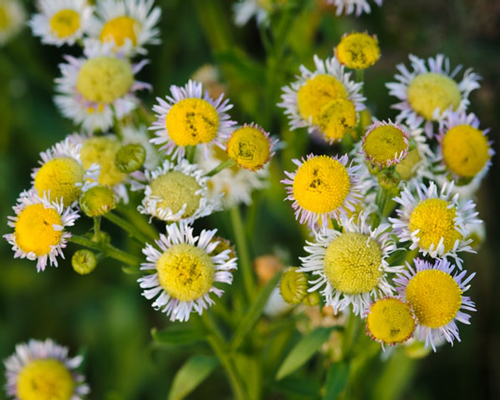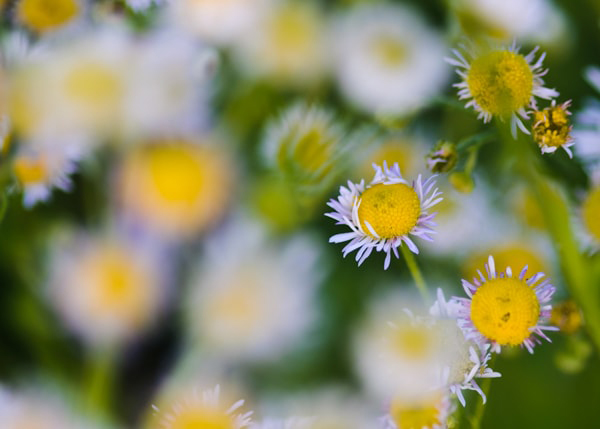Asteraceae includes well over 20,000 species by anyone’s count, many of which are familiar: daisies, sunflowers, dandelions, marigolds. The word aster means “star” in ancient Greek (think astronomy, not celebrities). You can see that the name is very fitting; daisies, sunflowers and marigolds look like stars.
So do the flowerheads of prairie fleabane. Each plant produces constellations of diminutive stars.

You probably noticed that I wrote “flowerheads” instead of “flowers.” It’s not just a poetic whim that made me write that. It might sound odd, but I need to ask you: What is the flower of an aster? What part of an aster is the flower?
You see, what we call a flower when we talk about a daisy or fleabane—the yellow center with white petals—is actually a cluster of flowers. Yes, an aster “flower” is actually many flowers tightly packed together.
Actually, it’s more complicated. An aster “flower” is two types of flowers (or florets) that grow together: disk florets and ray florets. A structure of flowers growing tightly together is called an inflorescence. The inflorescence of an aster is called a capitulum, which means “little head” in Latin. We can just call them flowerheads.
Nothing is simple with asters, even though they’re so familiar!
Disk florets are the tiny, tubular flowers in the center of the flowerhead. Take a look at a fleabane flowerhead. You might need a magnifying glass to see the minute, yellow disk florets, but it’s worth the effort.
That’s the center; what about the petals? A single prairie fleabane flowerhead has 40 to 100 ray florets. Each ray floret produces what we would call a petal. That’s right, each petal of an aster is actually the product of a single floret. The petals are generally white, but they can sometimes be pink or lavender. They look like thin, delicate daisy petals only around half-an-inch long.
Botanists call the petal of an aster a ligule, which means “little tongue” in Latin. Why don’t they just call it a petal? Because it’s actually three petals fused together. If you’ve ever wondered why dandelion petals have little teeth at the end of them, this is why: a dandelion “petal” is actually three petals fused into one ligule. The teeth are the points of the fused petals.
With prairie fleabane, the disk florets are bisexual, having both stamens and pistils. The ray florets only have pistils.
And all of these parts somehow evolved to produce what looks to our eyes like a single, normal flower!
(Nature is amazing, isn’t it?)
That’s a lot about flowerheads! Where does prairie fleabane fit ecologically?

Prairie fleabane is a pioneer species. Pioneer species are those hardy species that move into disturbed areas first. A disruption could be a fire, a natural disaster like a tornado or a human activity like construction, plowing or even restoration. It’s no shock that, after a controlled burn earlier this year, the Arboretum is covered in a pioneer like fleabane.
Pioneer species fulfil many ecologically beneficial functions. They help to stabilize the soils that have been exposed by disruption. They provide food and shelter for animals. Fleabane provides copious nectar for many species of bees, as well as good forage for herbivorous mammals. In death, they provide the decomposing material of richer soils to come.
In short, pioneer species like fleabane lay the groundwork for a healthy, more stable ecosystem.

As you’d guess from the first part of its name, prairie fleabane is particularly adapted to open and dry spaces. It’s quite common, although perhaps overlooked because it is so common. You can find it performing its role as pioneer as you walk around the streets of Milwaukee, growing in margins along roads.
A bit more about its name: prairie fleabane is also known as daisy, rough, hairy or common eastern fleabane. The common name fleabane comes from a folk belief that fleabane repels fleas. It doesn’t. The scientific name Erigeron means “old man of the spring,” because it produces fluffy, white seedheads and many species of Erigeron bloom early in the season. Strigosus means “thin.” Presumably this name comes from the fact that the leaves of prairie fleabane are thin compared to other fleabanes like the very similar Annual Fleabane (Erigeron annuus).
The prairie landscape can be overwhelming with so many flowers to look at. Try going to the Arboretum, pausing and taking a closer look at prairie fleabane.
Many thanks to our guest blogger, Jonathan Abresch, for this great post! Jonathan is an American-Canadian writer and photographer who loves learning about and being in nature. This article is part of a series of blogs on native Wisconsin wildflowers for the Urban Ecology Center that will be appearing over the course of the coming months. Do you have any comments, corrections or suggestions? Please get in touch with Jonathan at This email address is being protected from spambots. You need JavaScript enabled to view it..





